Bat Trang is a renowned ceramic village in Vietnam, located about 13 km northeast of Hanoi. Bat Trang ceramics, known for their exquisite craftsmanship and cultural significance, have long been an integral part of Vietnamese heritage. Over the years, these ceramics have gained popularity not only among the locals but also in international markets. This article delves into the expanding world of Bat Trang ceramic exports, highlighting the challenges faced and the new markets that have emerged.
Bat Trang Ceramics: A Brief Overview
Bat Trang ceramics, originating from the traditional pottery village of Bat Trang in Vietnam, have gained recognition and popularity worldwide for their exquisite craftsmanship, unique designs, and rich cultural heritage. This report provides a comprehensive overview of Bat Trang ceramics, exploring their history, production process, notable characteristics, and their significance in the global market.
Bat Trang, located in the Gia Lam district of Hanoi, has been a prominent center for ceramic production for over 600 years. The village’s ceramic tradition dates back to the Ly dynasty in the 14th century when skilled artisans settled in the area and began creating pottery. Since then, Bat Trang has flourished as a hub of ceramic craftsmanship, passing down its knowledge and techniques from generation to generation.
Bat Trang ceramics are renowned for their meticulous production process, combining traditional methods with modern innovations. The process involves several stages, including clay preparation, shaping, decoration, glazing, and firing. Artisans meticulously handcraft each piece, paying attention to intricate details and maintaining the highest quality standards. The firing process takes place in kilns at high temperatures, ensuring durability and longevity of the ceramic products.
The ceramics are characterized by their distinct features and artistic expressions. The artisans incorporate a wide range of design motifs, including floral patterns, landscapes, and traditional Vietnamese symbols, reflecting the country’s cultural heritage. The color palette is diverse, ranging from vibrant and bold hues to subtle and earthy tones. Each piece showcases the skillful craftsmanship and attention to detail that Bat Trang ceramics are known for.
Bat Trang ceramics offer a diverse range of products, catering to various needs and preferences. The product catalog includes decorative items such as vases, figurines, and sculptures, as well as functional pieces like bowls, plates, teapots, and tableware sets. These products are available in different sizes, shapes, and designs, allowing customers to choose according to their personal style and requirements.
Bat Trang products hold immense cultural significance for Vietnam. They represent the country’s artistic heritage and serve as a medium to preserve traditional craftsmanship. The ceramics also embody Vietnamese cultural values and aesthetics, reflecting the harmonious blend of nature, spirituality, and everyday life. Bat Trang ceramics have become iconic symbols of Vietnamese culture and are often showcased in museums, exhibitions, and cultural events.
Bat Trang ceramics have achieved international recognition and have a strong presence in the global market. Their artistic appeal, exceptional quality, and cultural significance have made them sought-after commodities worldwide. Bat Trang ceramics are exported to numerous countries, including Japan, South Korea, Europe, the United States, and beyond. The international demand for Bat Trang ceramics continues to grow, contributing to the village’s economic development and promoting Vietnam’s cultural heritage on a global scale.
In brief, Bat Trang ceramics have a rich history and cultural significance that has transcended centuries. The artisans’ dedication to craftsmanship, combined with their ability to infuse tradition with contemporary designs, has made Bat Trang ceramics highly desirable in the global market. As these ceramics continue to captivate art enthusiasts and collectors worldwide, they play a crucial role in preserving Vietnam’s cultural legacy and establishing Bat Trang as a renowned center for ceramic excellence.
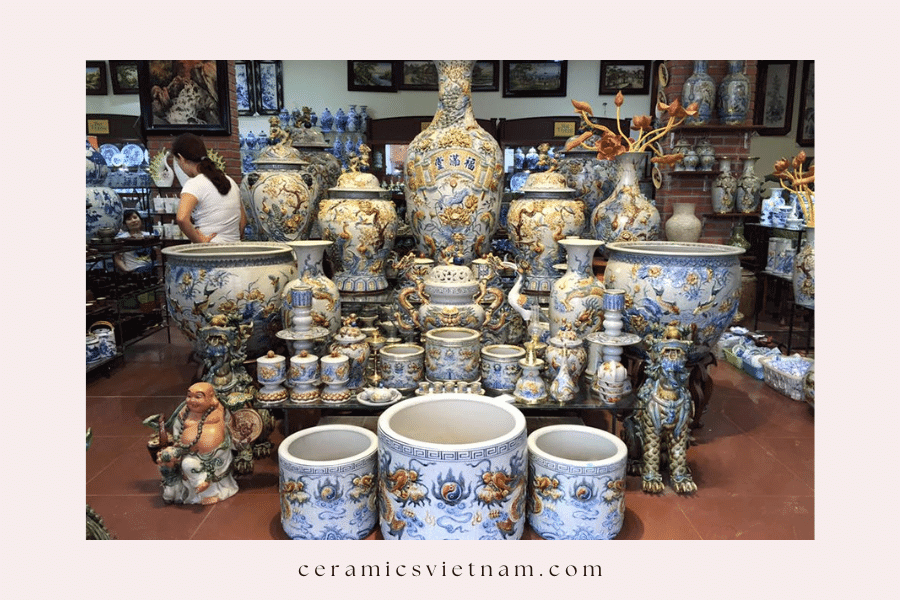
A Brief Overview about Bat Trang Ceramics
The Changing Landscape of Bat Trang Ceramic Exports
Traditional Routes and the Dominance of China
Historically, the export of Bat Trang ceramics followed traditional routes, facilitated by local traders who played a pivotal role in connecting the village to international markets. Among these routes, the largest export market for Bat Trang ceramics was China, which held a significant share of these exquisite products. For years, Chinese demand for Bat Trang ceramics fueled the growth of the industry and established it as a prominent player in the global ceramic trade.
However, as the global economy evolved and trade dynamics shifted, Bat Trang ceramics faced formidable challenges from the dominance of Chinese ceramics. China, with its massive ceramic production capacity, was able to offer products at lower prices due to economies of scale and streamlined industrial manufacturing processes. This inundation of inexpensive Chinese ceramics in the market created intense competition for Bat Trang ceramics, affecting their market share and profitability.
Seeking New Directions
In response to the increasing competition and changing market dynamics, the artisans and residents of Bat Trang realized the necessity of exploring new directions and diversifying their export markets. To sustain the growth of the industry and preserve the unique heritage of Bat Trang ceramics, the village embarked on a journey to seek alternative markets and develop innovative strategies.
One such strategy was to focus on expanding exports to non-traditional markets. Bat Trang ceramics began to venture into countries beyond China, targeting regions with a growing appreciation for handmade, artisanal products. These efforts included targeting markets in Japan, South Korea, Europe, the United States, and other regions that valued the artistry, craftsmanship, and cultural significance of Bat Trang ceramics.
Furthermore, recognizing the importance of differentiation and product positioning, Bat Trang artisans and manufacturers started to emphasize the distinctive qualities and artistic value of their ceramics. They highlighted the meticulous handcrafting process, the incorporation of traditional Vietnamese design motifs, and the use of high-quality materials. By showcasing the unique characteristics of Bat Trang ceramics, the village aimed to create a niche market that valued authenticity, craftsmanship, and cultural heritage.
Additionally, Bat Trang ceramics leveraged the power of digital platforms and e-commerce to expand their reach and connect with international buyers directly. Online marketplaces and social media platforms provided a cost-effective and efficient means for artisans to showcase their products, engage with potential customers, and facilitate direct transactions. This shift towards digital channels helped overcome the limitations of traditional distribution networks and opened up opportunities for global exposure and sales growth.
The dominance of Chinese ceramics in the global market presented significant challenges to the export of Bat Trang ceramics. However, the artisans and residents of Bat Trang demonstrated resilience and adaptability by seeking new directions and exploring alternative markets. By diversifying their export destinations, emphasizing the unique qualities of their ceramics, and leveraging digital platforms, Bat Trang ceramics have managed to sustain their growth and continue preserving their cultural heritage. As the industry evolves, the journey to find new avenues for export remains a crucial aspect of ensuring the long-term success and global recognition of Bat Trang ceramics.
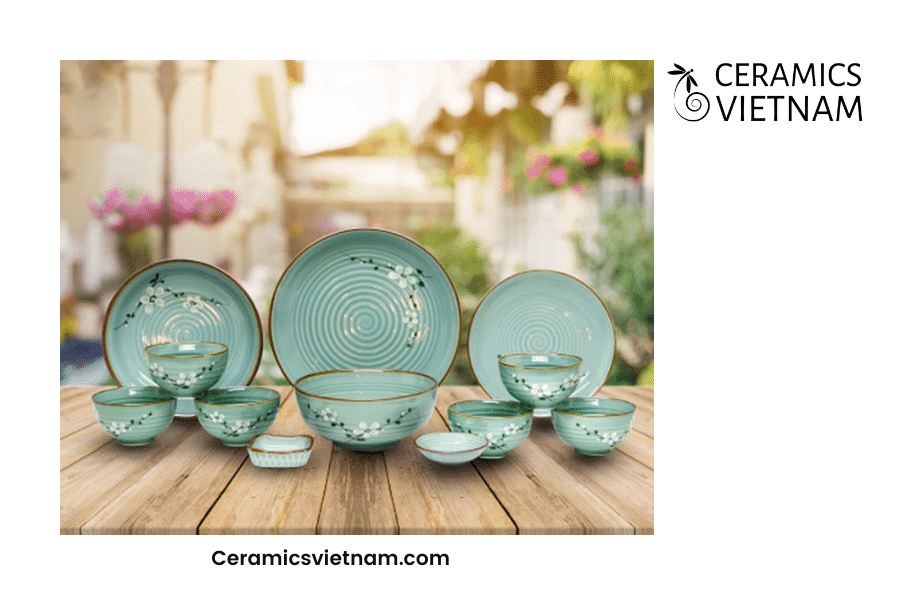
The Changing Landscape of Bat Trang Ceramic Exports
Emerging Markets for Bat Trang Ceramic Exports
Taiwan: A Cultural Affinity for Ceramics
Taiwan emerged as one of the primary target markets for Bat Trang ceramics, owing to its cultural similarities with China and a strong affinity for ceramic products. The shared cultural heritage and historical ties between Taiwan and China created a natural demand for Bat Trang ceramics in Taiwan.
In the early stages, Bat Trang exports to Taiwan primarily consisted of artistic and utility ceramics. Beautiful flower vases adorned with intricate designs and charming small desktop pots became sought-after items among Taiwanese consumers. These delicate and visually appealing pieces added elegance and artistic flair to homes and office spaces, appealing to the Taiwanese market’s aesthetic sensibilities.
As the demand for Bat Trang ceramics continued to grow in Taiwan, the range of products expanded to include larger pots, umbrella stands, and ceramics with intricate patterns. The versatility and functionality of these ceramics made them popular choices for both decorative and practical purposes in Taiwanese households. These larger pieces served as eye-catching focal points, while the intricate patterns added a touch of sophistication to interior spaces.
Taiwanese consumers, known for their appreciation of quality craftsmanship and attention to detail, recognized the artistic value and cultural significance of Bat Trang ceramics. The meticulous handcrafting process and the use of high-quality materials resonated with the discerning Taiwanese market. The unique blend of traditional Vietnamese design motifs with contemporary aesthetics appealed to their taste for blending tradition with modernity.
Furthermore, the growing popularity of Taiwanese tea culture provided another avenue for the export of Bat Trang ceramics. Tea sets, teapots, and tea cups became sought-after items among tea enthusiasts in Taiwan. The exquisite designs and craftsmanship of Bat Trang ceramics complemented the elegant tea-drinking rituals practiced in Taiwan, making them an ideal choice for tea connoisseurs.
As Bat Trang ceramics gained recognition and established a strong presence in the Taiwanese market, collaborations with local distributors, retailers, and online platforms became crucial for expanding market reach. These partnerships facilitated effective distribution channels, allowing Bat Trang ceramics to reach a wider audience of Taiwanese consumers.
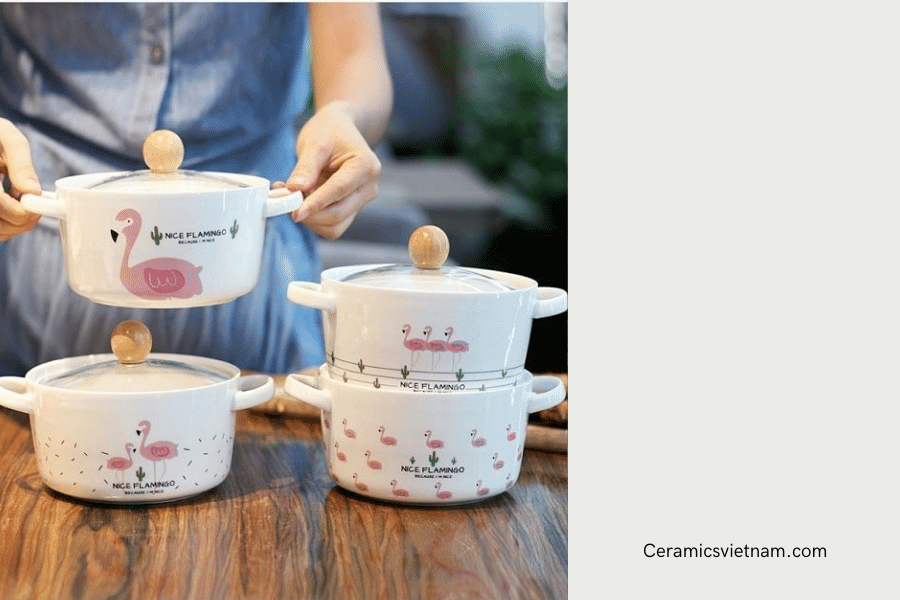
Emerging Markets for Bat Trang Ceramic Exports
Diversifying into New Markets
In addition to Taiwan, Bat Trang ceramics have made significant strides in various other countries, catering to specific market demands and preferences. Let’s delve into more detail about the international markets where Bat Trang ceramics have gained traction:
- The Netherlands: The Dutch market has exhibited a strong affinity for a diverse range of ceramic flower pots. From glazed to unglazed red clay pots, Dutch consumers appreciate the versatility and aesthetic appeal of these products. Additionally, seasonal flower vases, inspired by the association of the Netherlands with tulips, have become popular due to their connection with the country’s national flower.
- Denmark: Bat Trang ceramics have found a prominent place in the Danish market, particularly for tableware and large red clay pots used in firing. Danish consumers value the combination of functionality and visual appeal offered by Bat Trang ceramics, making them a favored choice for enhancing their homes and dining experiences.
- United States: The American market has shown a strong preference for the traditional crackle glaze technique seen in Bat Trang ceramics. The mesmerizing crackle glaze finish can be found on vases, flower pots, and antique-style plates, primarily in earthy tones. These products resonate with American consumers who appreciate the authenticity and nostalgic charm of traditional craftsmanship.
- Japan: Renowned for its deep-rooted tea culture, Japan has displayed a robust demand for Bat Trang ceramics, particularly the Tam Thai style ceramics. These tricolored ceramics have captivated Japanese consumers who admire the intricate craftsmanship and cultural significance they represent. Small desktop flower pots and various tea-related ceramic items, including teapots and tea cups, also enjoy popularity in the Japanese market due to their association with traditional tea rituals.
- South Korea: Bat Trang ceramics have gained popularity in South Korea, where consumers favor slender and tall flower pots adorned with bamboo-themed designs. The elegant aesthetics and artistic details of Bat Trang ceramics resonate with the Korean market, adding a touch of sophistication and natural beauty to their living spaces.
- France: French consumers have shown an appreciation for the exceptional craftsmanship and artistic value of Bat Trang ceramics. Decorative vases, tableware, and unique art pieces have found their way into French homes, adding an element of elegance and refinement to their interiors.
By recognizing the unique demands of each market and tailoring their product offerings accordingly, Bat Trang artisans have successfully diversified their exports and met the preferences of customers around the world. The ability to adapt their traditional craftsmanship to cater to diverse cultural tastes has been instrumental in the global recognition and growing success of Bat Trang ceramics.
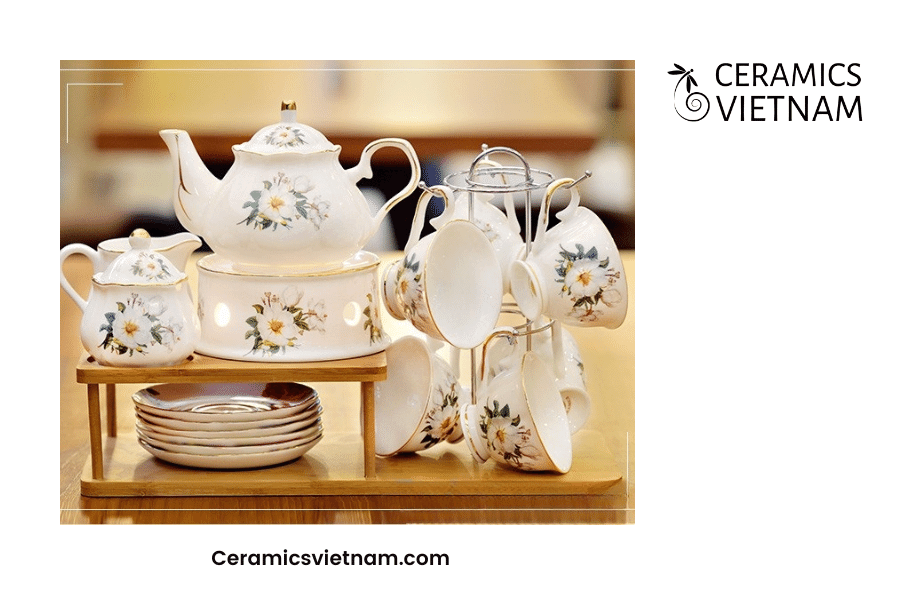
Bat Trang ceramics have made significant strides in various other countries
Export Statistics and Trends
Bat Trang ceramics have not only gained popularity in various international markets but have also contributed significantly to Vietnam’s export industry. According to recent reports, the export turnover of ceramics and porcelain from Bat Trang reached an impressive 509 million USD in 2018. This achievement showcases the growing demand and recognition of Bat Trang ceramics on the global stage.
Furthermore, projections indicate that the export value of Bat Trang ceramics is expected to continue its upward trajectory in the following year. If the growth rate for the remaining 5 months of 2019 maintains the same pace as the first 7 months of the year, with an increase of 4.6%, the total export value for the entire year is projected to reach a remarkable 532 million USD.
These figures demonstrate the consistent growth and promising prospects for the Bat Trang ceramics industry. The ability to expand into new markets and cater to diverse consumer preferences has played a vital role in the success of Bat Trang ceramics as an export commodity. The combination of exceptional craftsmanship, cultural heritage, and adaptability to meet international market demands has positioned Bat Trang ceramics as a prominent player in the global ceramics trade.
As Bat Trang ceramics continue to captivate the hearts of consumers worldwide with their exquisite designs, rich history, and enduring quality, the future looks bright for this traditional Vietnamese craft. With continued efforts to explore new markets, adapt to evolving consumer preferences, and maintain the exceptional quality that Bat Trang ceramics are renowned for, the industry is poised to make even greater strides in the coming years, further solidifying Vietnam’s position as a leading exporter of ceramics and porcelain.
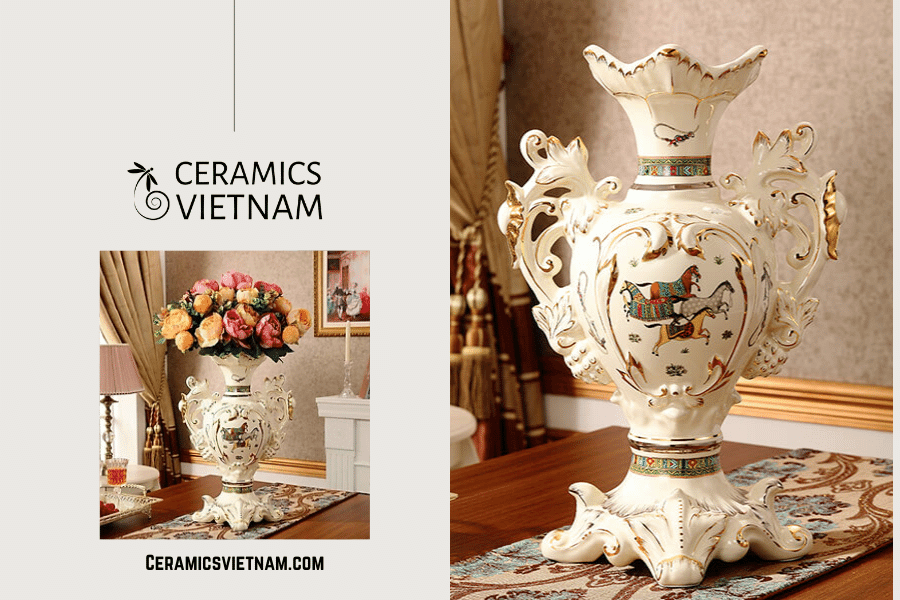
Bat Trang ceramics have contributed significantly to Vietnam’s export industry
The Vietnamese Diaspora: Serving the Global Vietnamese Community
In addition to the impressive growth in international markets, Bat Trang ceramic exports have also played a significant role in serving the needs of the Vietnamese diaspora scattered across the globe. Recognizing the importance of cultural preservation and maintaining a connection with their roots, Vietnamese communities residing abroad have embraced Bat Trang ceramics as a way to celebrate their heritage and showcase their cultural identity.
Bat Trang ceramics, with their diverse range of products, have been well-received by Vietnamese communities in various countries. Items such as plates, teapots, household utensils, and artistic ceramics have been exported to countries with substantial Vietnamese populations, including the United States, France, Australia, Canada, and others. These exports not only satisfy the demand for quality ceramic products but also provide a sense of nostalgia and connection to the homeland.
For Vietnamese expatriates, Bat Trang ceramics act as tangible reminders of their cultural heritage and serve as a way to preserve traditions within their new communities. These ceramics not only adorn homes and dining tables but also become conversation pieces that spark discussions about Vietnamese customs and traditions. They serve as a bridge between generations, allowing the younger members of the diaspora to learn and appreciate their cultural roots.
Furthermore, Bat Trang ceramics contribute to cultural events and festivals organized by Vietnamese communities abroad. They are often showcased and used during traditional celebrations, helping to create a vibrant and authentic atmosphere. The intricate designs and craftsmanship of Bat Trang ceramics serve as a testament to Vietnam’s rich cultural heritage, captivating not only the Vietnamese diaspora but also individuals from other cultural backgrounds who appreciate the beauty and artistry of these ceramics.
By meeting the demands of the Vietnamese diaspora, Bat Trang ceramics not only generate economic benefits but also contribute to the preservation and promotion of Vietnamese culture on a global scale. The export of these ceramics allows the Vietnamese community to maintain a strong connection with their homeland, fostering a sense of pride and identity among individuals living abroad.
In conclusion, Bat Trang ceramics have successfully ventured beyond the domestic and Chinese markets, embracing new opportunities and capturing the attention of global consumers. With a focus on diversifying their product offerings and understanding the preferences of different cultures, Bat Trang artisans have embarked on a journey to establish themselves in the global ceramic industry. As they navigate the challenges of the ever-evolving economic landscape, Bat Trang ceramics continue to be a symbol of Vietnam’s rich cultural heritage, cherished both within the country and across borders.
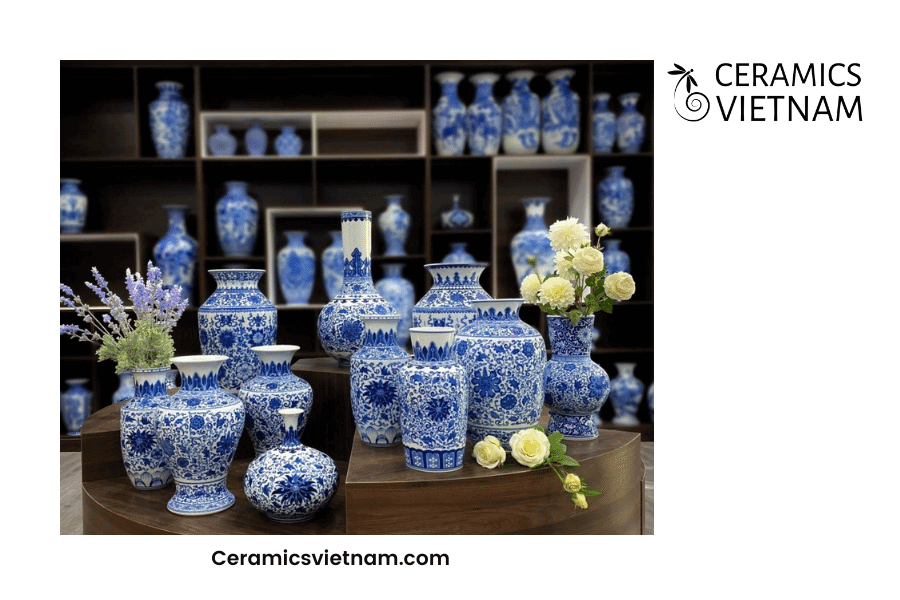
Emerging Markets for Bat Trang Ceramic Exports
Challenges of Bat Trang Ceramic Exports
Bat Trang ceramics, renowned for their exquisite craftsmanship and cultural heritage, face significant challenges in the export market. In recent years, the emergence of competitive Chinese ceramics has posed a formidable threat to Bat Trang’s international presence. This article explores the specific challenges encountered by Bat Trang ceramic exports and the potential strategies to overcome them.
Significant challenges in the ceramics export market
The rapid growth of Chinese ceramics, produced on an industrial scale, has created intense competition for Bat Trang ceramic exports. Chinese ceramics benefit from fast production times, a wide range of designs, and cost-effectiveness. In contrast, Bat Trang ceramics maintain their traditional handmade production methods, relying on manual craftsmanship and employing outdated machinery. This stark contrast puts Bat Trang ceramics at a disadvantage in terms of production efficiency and price competitiveness.
Another major challenge faced by Bat Trang ceramic exports is the limited resources and outdated infrastructure within the industry. Most Bat Trang companies are small-scale businesses with insufficient capital to fulfill large orders or invest in modern machinery. Moreover, the lack of supportive policies and access to financing options, such as stock issuance, further impedes their growth and expansion potential.

Significant challenges in the Bat Trang ceramics export market
Overcoming Competition and Limited Resources
To address these challenges and propel Bat Trang ceramic exports to new heights, it is crucial to seek government support and favorable policies. The Vietnamese government plays a vital role in fostering the growth of the ceramic industry by providing financial assistance, promoting modernization, and facilitating access to international markets. By implementing supportive measures, such as subsidies, low-interest loans, and capacity-building programs, the government can empower Bat Trang artisans and businesses to enhance their production capabilities, improve product quality, and establish stronger footholds in the global market.
To remain competitive, Bat Trang ceramic exports must embrace innovation and modernization. By integrating advanced technology into their production processes, they can streamline operations, enhance efficiency, and meet the demands of international buyers. Adopting new machinery, kilns, and production techniques will not only increase productivity but also enable the creation of more diverse and contemporary designs that resonate with global consumers.
Collaboration and market diversification are key strategies for overcoming the challenges faced by Bat Trang ceramic exports. By partnering with international distributors, engaging in trade fairs and exhibitions, and leveraging digital marketing platforms, Bat Trang ceramics can expand their reach and tap into new markets. Targeting niche markets with unique product offerings tailored to specific consumer preferences can help differentiate Bat Trang ceramics and create a competitive edge in the global arena.
Despite the challenges posed by fierce competition and limited resources, Bat Trang ceramics have the potential to thrive in the export market. By seeking government support, embracing innovation, and exploring new markets, Bat Trang ceramic exports can overcome these obstacles and continue to showcase Vietnam’s rich cultural heritage to the world. With concerted efforts and strategic initiatives, the future holds immense possibilities for Bat Trang ceramics to flourish on the global stage.
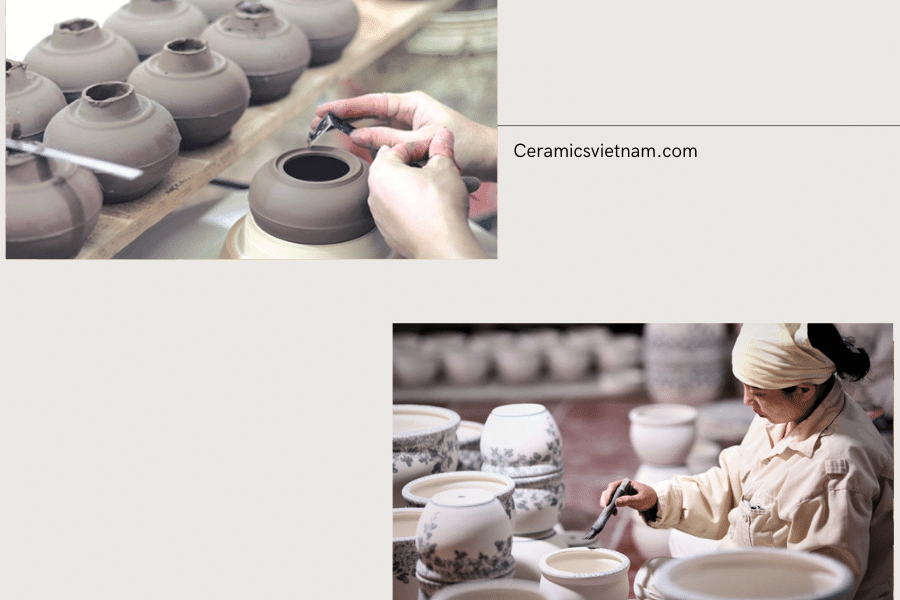
Facing the challenges of Bat Trang Ceramic Exports
Prominent Bat Trang Ceramics Exported
Bat Trang ceramics are renowned for their exceptional craftsmanship and artistic beauty, making them highly sought-after in the global export market. In this SEO article, we will delve into the key export products from Bat Trang and explore their significance in international trade.
Ceramic Pots
Bat Trang ceramics offer a diverse range of ceramic pots that have gained significant traction in both the home decoration and agricultural sectors. These versatile pots cater to the needs of customers seeking aesthetically pleasing options for enhancing their living spaces or utilizing them for agricultural purposes. The ceramic pots are available in a wide range of sizes, accommodating various plant types and dimensions. Additionally, they come in eye-catching colors that add vibrancy and charm to any setting.
One of the key factors contributing to the popularity of Bat Trang ceramic pots is their competitive pricing. Despite their high-quality craftsmanship and artistic appeal, these pots are priced competitively, making them accessible to a broad range of customers. This affordability factor has played a significant role in driving the demand for Bat Trang ceramic pots in both domestic and international markets.
To ensure the safe transportation of these delicate ceramic pots, meticulous packaging measures are implemented. Each pot is carefully packed in paper boxes, providing cushioning and protection during transit. These boxes are designed to withstand the rigors of shipping, preventing damage or breakage. Furthermore, to facilitate efficient transportation, ceramic pots are shipped in containers via sea freight, ensuring their timely delivery to customers worldwide.
The export of ceramic pots from Bat Trang has emerged as a thriving industry, fueled by the versatility and appeal of these products. Their ability to serve both decorative and agricultural purposes has garnered attention from customers across different markets. The demand for ceramic pots continues to grow, driven by the increasing appreciation for their aesthetic value, durability, and functional benefits.

Prominent Bat Trang Ceramics Exported – Ceramics Pot
Teapots and Tea Sets
Bat Trang teapots and tea sets have garnered significant acclaim in the global market, particularly in regions such as Japan, South Korea, and Europe. The export success of Vietnamese ceramics, including the renowned Bat Trang ceramics, to these destinations hinges on the utmost dedication to product quality and adherence to strict standards.
To cater to the discerning preferences of these markets, it is imperative to prioritize product quality. Bat Trang artisans pay meticulous attention to detail, ensuring that each teapot and tea set meets the highest standards of craftsmanship. The production process involves the use of premium materials, skillful shaping, and delicate finishing, resulting in exquisite pieces that exemplify the artistry of Bat Trang ceramics.
In addition to quality, meeting health and safety regulations is crucial for exporting ceramics to Japan, South Korea, and Europe. Compliance with stringent standards ensures that the teapots and tea sets are safe for use and meet the expectations of discerning consumers. This involves rigorous testing, quality control measures, and certifications to guarantee the highest level of safety and reliability.
Cultural customization is another key aspect of successfully exporting Bat Trang teapots and tea sets to these regions. Understanding the unique preferences and traditions of each market is essential for tailoring the products accordingly. Traditional teapot designs, such as the classic white teapots and the revered purple clay teapots, resonate with the appreciation for heritage and authenticity in these markets. Moreover, the rising popularity of high-end transforming enamel teapots showcases the adaptability and innovation of Bat Trang ceramics.
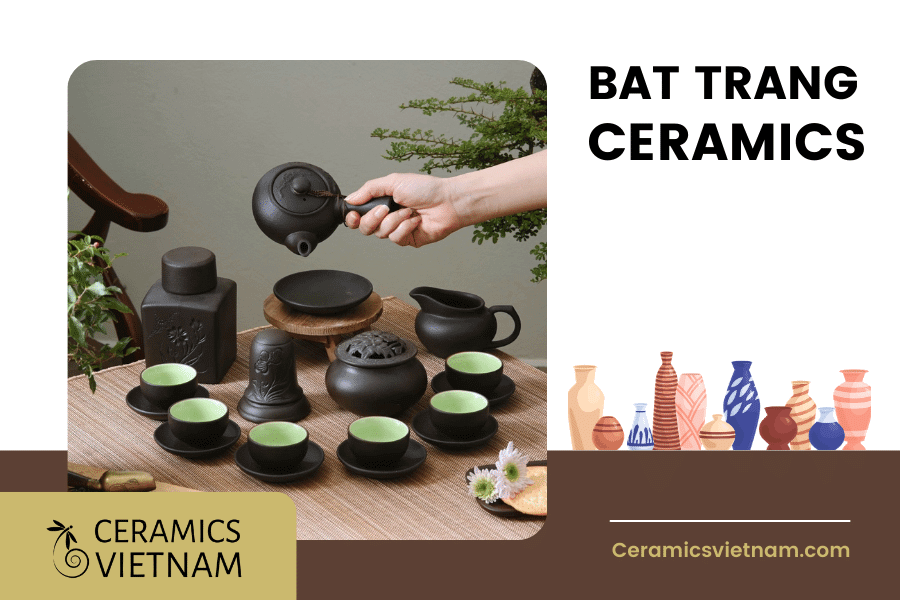
Prominent Bat Trang Ceramics Exported – Teapots and Tea Sets
Ceramic Jars
Ceramic jars are esteemed for their exceptional durability and versatility in storing a wide range of substances, including alcohol, food, salt, and other consumables. These jars are meticulously crafted using high-quality ceramic materials that are carefully coated with a glaze, offering robust protection against water or salt corrosion.
The production process of ceramic jars involves subjecting them to high firing temperatures, typically ranging from 1200 to 1300 degrees Celsius. This intense heat ensures the solidity and reliability of the jars, making them suitable for long-term storage. The firing process plays a pivotal role in enhancing the strength of the ceramic material, making it resilient to external factors.
One of the remarkable qualities of ceramic jars lies in their ability to effectively preserve and safeguard food items. The airtight nature of these jars prevents the infiltration of moisture, contaminants, and unwanted pests. By creating a secure and hygienic storage environment, ceramic jars ensure that the stored food remains fresh and untainted for extended periods.
The sturdy construction and protective glaze of ceramic jars make them highly resistant to external influences, including impacts, temperature fluctuations, and chemical reactions. This durability allows them to withstand the rigors of transportation and long-term storage without compromising the quality of the stored substances.
The versatility of ceramic jars makes them an indispensable choice for various applications. Whether used in households, restaurants, or food processing industries, these jars offer an optimal solution for preserving the flavor, quality, and safety of stored food items. Their aesthetic appeal and timeless charm further contribute to their popularity as a preferred storage option.
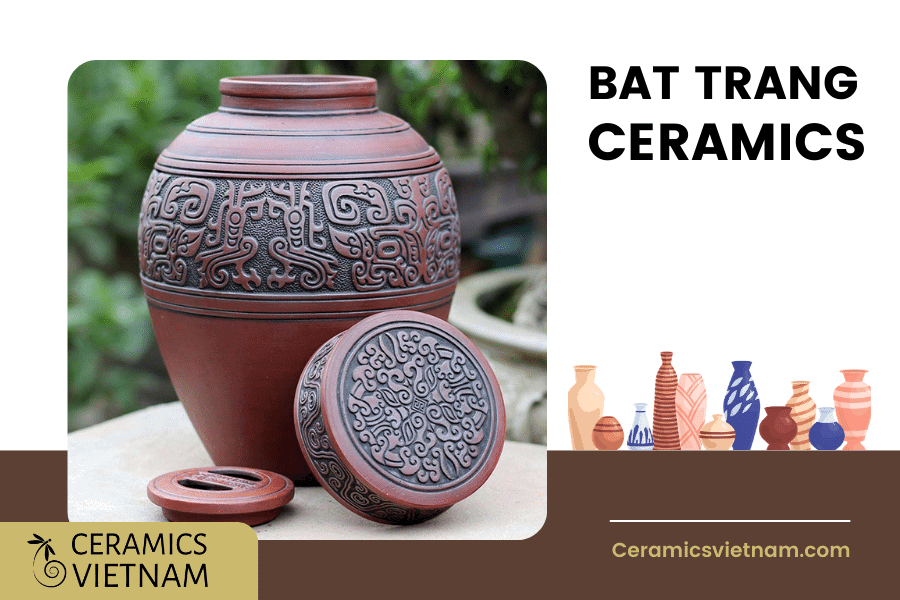
Prominent Bat Trang Ceramics Exported – Ceramic jars
Vases
Vases play a significant role as highly sought-after export products in the extensive catalog of Bat Trang ceramics. Renowned for their ability to elevate the aesthetic appeal of luxurious living spaces, including living rooms, hotels, and upscale restaurants, these vases exude an unparalleled sense of elegance and sophistication.
One of the key factors driving the popularity of Bat Trang vases is their captivating and intricately designed aesthetics. Crafted with meticulous attention to detail, these vases showcase exquisite patterns, motifs, and ornamentation that showcase the exceptional craftsmanship of Bat Trang artisans. The combination of traditional techniques and contemporary influences results in vases that effortlessly blend timeless beauty with modern sensibilities.
Bat Trang vases have garnered significant recognition and demand from customers worldwide. Their ability to enhance the ambiance of living spaces and serve as captivating decorative accents has made them highly coveted items. The allure of these vases lies not only in their visual appeal but also in their ability to evoke a sense of sophistication and refinement in any setting.
Among the wide array of vases available, the lục bình vases, a traditional Vietnamese style of vases characterized by their distinctive hexagonal shape, remain particularly popular in various markets. The demand for Vietnamese imported vases, including the lục bình vases, has consistently remained high, reflecting the global appreciation for the unique cultural heritage and craftsmanship of Bat Trang ceramics.
The versatility of Bat Trang vases allows them to cater to diverse customer preferences and interior design styles. Whether it is a classic, minimalist, or contemporary setting, these vases effortlessly complement and enhance the overall aesthetic appeal of any space. Their ability to serve as statement pieces or elegant accents contributes to their timeless appeal and makes them highly sought-after in the international market.
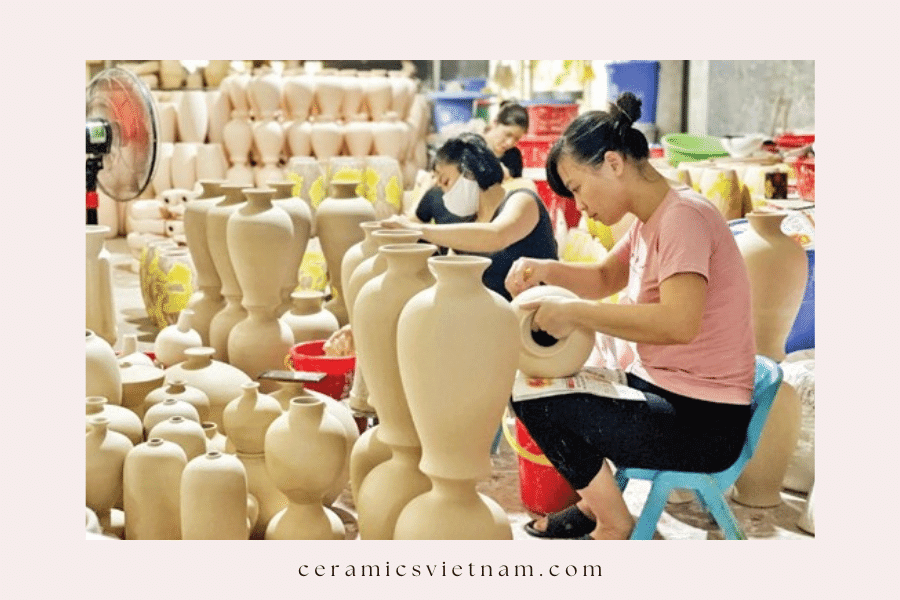
Prominent Bat Trang Ceramics Exported – Vases
Cups and Ceramic Tableware
Cups and ceramic tableware hold a pivotal role as indispensable items in households across the globe. Within the ceramic industry of Bat Trang, the export of cup and ceramic tableware sets forms a substantial segment, with significant quantities being shipped annually to meet the global demand.
Bat Trang’s reputation for producing high-quality ceramics is exemplified in its cup and tableware offerings. Meticulously crafted with attention to detail, these products showcase the exceptional skills and expertise of Bat Trang artisans. From delicate tea cups to elegant dinnerware sets, the diverse range of cup and ceramic tableware designs caters to various preferences and occasions.
One notable aspect of the export market for cups and ceramic tableware is the option for personalized logo printing. This feature has gained popularity, particularly in markets such as the United States and other regions, as it allows businesses and individuals to add a unique touch to these everyday essentials. Personalized logo printing offers branding opportunities, making cups and tableware sets ideal for promotional purposes, corporate gifting, or personalized home decor.
The versatility and functionality of Bat Trang cup and ceramic tableware sets make them highly sought-after by consumers worldwide. These products not only serve practical purposes but also enhance the dining experience with their aesthetic appeal. The intricate designs, vibrant colors, and fine craftsmanship of Bat Trang ceramics contribute to their desirability among customers who appreciate both beauty and functionality.
Furthermore, the export of cup and ceramic tableware sets contributes significantly to the economic growth of Bat Trang and the overall ceramics industry in Vietnam. The global demand for these products has led to increased production, generating employment opportunities for local artisans and supporting the local economy.
In conclusion, Bat Trang ceramics offer a diverse array of products that have garnered international acclaim in the export market. The exceptional craftsmanship, premium materials, and aesthetic allure of these ceramics contribute to their popularity and global demand. As the export industry continues to expand, Bat Trang ceramics will play a pivotal role in showcasing Vietnam’s rich cultural heritage to a global audience.
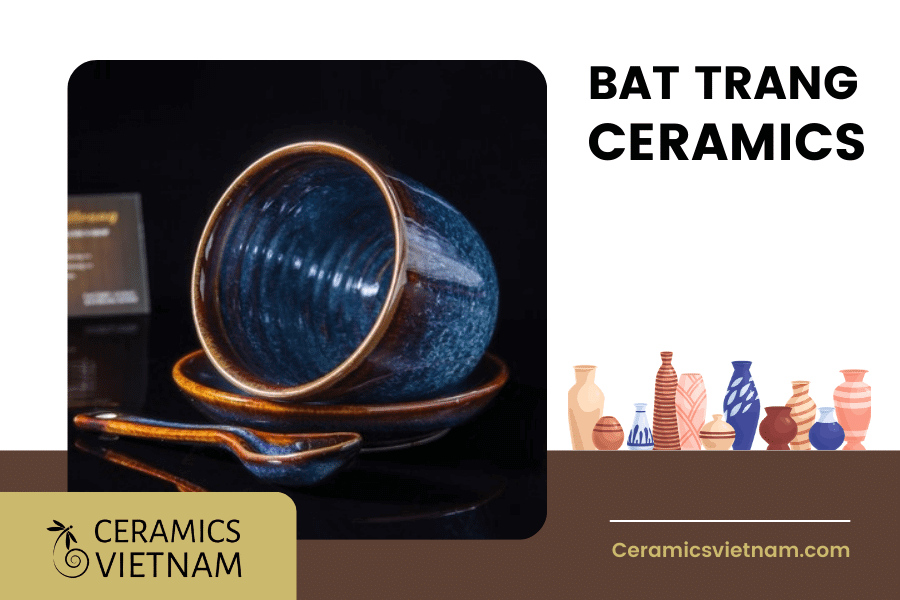
Prominent Bat Trang Ceramics Exported – Cups and Ceramic Tableware
Read more
Discover the enchanting beauty of Bat Trang pottery village in Hanoi
FAQs
- What are some of the popular export destinations for Bat Trang ceramics? Bat Trang ceramics are exported to a range of countries. Some prominent export destinations include Taiwan, the Netherlands, Japan, South Korea, Denmark, the United States, and France.
- How have Bat Trang ceramic exports adapted to competition from cheaper Chinese ceramics? To overcome competition from cheaper Chinese ceramics, Bat Trang ceramic exports have sought new markets and diversified their product offerings. They have focused on unique designs, craftsmanship, and catering to specific consumer preferences in different countries.
- What are some popular Bat Trang ceramic products in the international market? The international market favors Bat Trang ceramic dinnerware sets, decorative pieces, spiritual offering ceramics, tea sets, and home décor items due to their exquisite craftsmanship and artistic appeal.
- How do Bat Trang ceramic exports contribute to the country’s economy? The export of Bat Trang ceramics significantly contributes to Vietnam’s economy by generating substantial revenue, creating employment opportunities, and promoting cultural heritage.
- Why are Bat Trang ceramics sought after for home decoration? Bat Trang ceramics offer a blend of tradition and contemporary aesthetics, allowing homeowners to add a touch of Vietnamese culture and artistic elegance to their living spaces.














Leave a reply